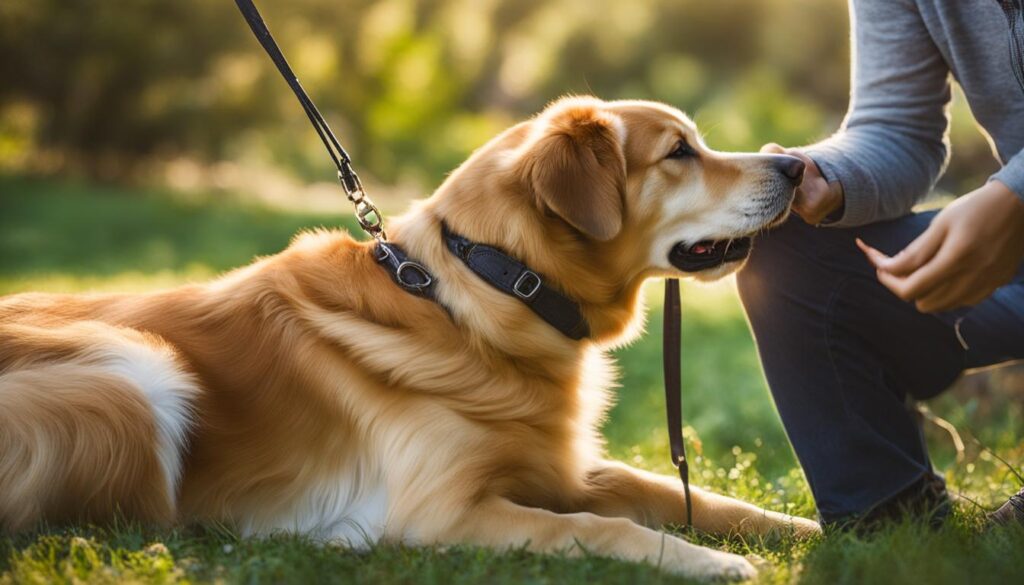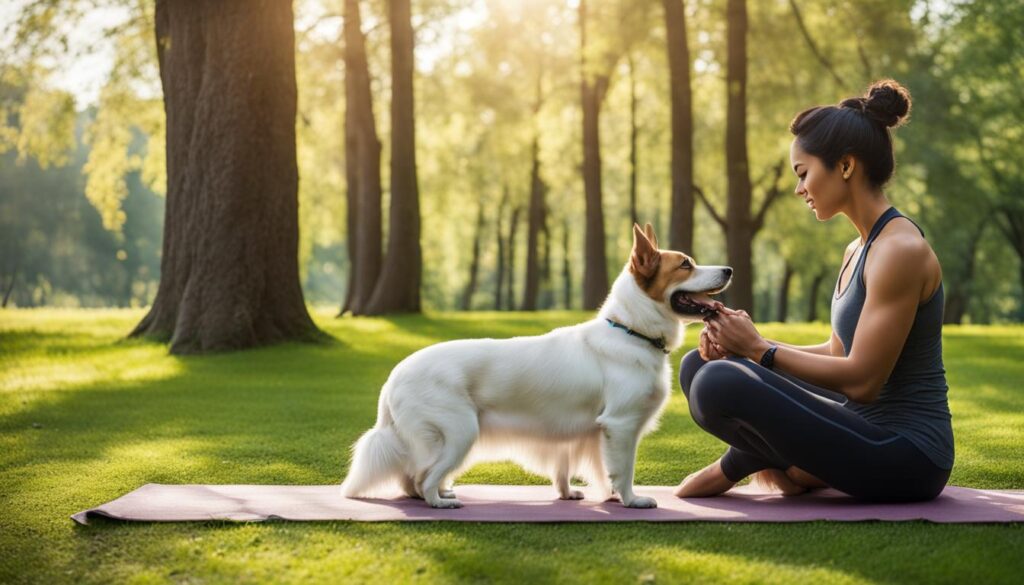Achieve Serenity: How to Live Calm with Dog
Living harmoniously with a canine companion can bring immense joy and fulfillment to your life. Dogs are often considered part of the family, and creating a calm and peaceful environment is essential for a harmonious coexistence. Whether you have a new puppy or a dog with anxiety, there are strategies and techniques you can implement to ensure a serene and tranquil living experience with your furry friend.
Key Takeaways:
- Understanding canine anxiety and recognizing the signs is crucial for addressing the root cause and alleviating stress.
- Creating a designated calm space for your dog, incorporating soothing elements, and maintaining a structured routine can foster a peaceful environment.
- Positive reinforcement training and socialization play significant roles in encouraging calm behavior and reducing anxiety.
- Regular exercise and mental stimulation are essential for your dog’s well-being, promoting harmonious living.
- Prioritizing your dog’s health with regular check-ups, a balanced diet, and proper grooming contributes to a calm demeanor.
Understanding Canine Anxiety
Dogs, just like humans, can experience anxiety and stress. It’s important to familiarize yourself with the signs of canine anxiety, such as excessive barking, destructive behavior, or trembling. By recognizing these signs, you can address the root cause of your dog’s anxiety and take steps to alleviate their stress.
There are various calming techniques that can help manage your dog’s anxiety and promote a sense of calm. Here are a few effective strategies:
- Provide a Safe Space: Creating a designated area where your dog can retreat to when they feel anxious can be immensely helpful. This can be a cozy crate, a comfortable bed, or a quiet room where they feel secure.
- Positive Reinforcement Training: Using positive reinforcement techniques, such as rewards and praise, can help your dog associate positive experiences with certain situations or triggers that may cause anxiety.
- Anxiety Wraps or Thundershirts: These specially-designed garments apply gentle pressure to your dog’s body, which can help reduce anxiety and promote a sense of calm.
Understanding and managing canine anxiety is crucial for both your dog’s well-being and your peace of mind. By implementing these calming techniques, you can create a harmonious environment that supports your dog’s emotional health.
The bond between you and your dog is a special one, and it is worth investing time and effort into helping them overcome anxiety. In the next section, we will explore how to create a calm environment that further promotes your dog’s well-being.
Creating a Calm Environment
Creating a calm environment is crucial for both you and your dog’s well-being. By implementing a few simple techniques, you can reduce stress and promote a peaceful atmosphere that benefits both you and your pet.
Structured Routine
Establishing a structured routine can provide a sense of security and predictability for your dog. Dogs thrive on consistency, so try to establish regular feeding times, exercise sessions, and bedtime routines. Consistency in your daily activities will help your dog feel more relaxed and comfortable.
Peaceful Home Environment
Keep your home environment as peaceful as possible to create a soothing atmosphere for your dog. Limit loud noises, such as blaring music or excessive television volume, as they can increase stress levels. Ensure a peaceful space for your dog by designating quiet areas where they can retreat to when they need a break.
“A calm home environment sets the foundation for a calm and happy dog.”
Reducing External Stressors
Identify and minimize external stressors that can affect your dog’s well-being. For example, if your dog becomes anxious during thunderstorms, provide a safe space for them to retreat to and consider using a calming wrap or thundershirt. Additionally, if your dog is sensitive to noise, consider using white noise machines or calming music to drown out disruptive sounds.
Creating a Designated Space
Having a designated space for your dog, such as a comfortable bed or a crate, can help them feel secure and calm. Make sure their space is cozy, well-ventilated, and filled with their favorite toys and blankets. This space will serve as their sanctuary where they can retreat to when they need privacy or relaxation.
“A comfortable space provides a sense of security, helping dogs feel calm and at ease.”
Incorporating Calming Scents and Music
Incorporating calming scents, such as lavender or chamomile, can have a soothing effect on your dog. You can use essential oil diffusers or herbal sprays to infuse your home with these scents. Additionally, playing soft and calming music can help create a tranquil atmosphere that aids in reducing stress levels.
| Techniques for Creating a Calm Environment | Benefits |
|---|---|
| Establishing a structured routine | Provides predictability and reduces anxiety |
| Creating a peaceful home environment | Promotes relaxation and reduces stress |
| Reducing external stressors | Minimizes triggers and anxiety-inducing factors |
| Creating a designated space | Gives your dog a safe and secure retreat |
| Incorporating calming scents and music | Aids in relaxation and creates a soothing atmosphere |
Training and Socialization
In order to have a calm and well-behaved dog, training and socialization are crucial. By implementing positive reinforcement training methods, you can teach your dog commands and appropriate behavior while providing them with mental stimulation. This helps your canine companion understand expectations and builds a strong bond between you and your furry friend.
Training Tips for a Calm Dog
- Start with basic obedience commands such as sit, stay, and come. Use positive reinforcement techniques like treats, praise, and rewards to motivate your dog to learn.
- Be consistent and patient in your training. Dogs thrive on routine and repetition, so practice commands regularly in various environments to reinforce their understanding.
- Use a clicker or a verbal marker like “yes” to mark desired behaviors. This helps your dog associate the sound with receiving a reward and reinforces good behavior.
- Avoid punishment-based training methods, as they can increase anxiety and fear in dogs. Instead, focus on rewarding positive behaviors and redirecting unwanted behaviors to more appropriate alternatives.
- Consider enrolling in a positive reinforcement-based obedience class or hiring a professional dog trainer who specializes in calm and balanced training techniques.
Socialization for a Peaceful Canine Companion
Socializing your dog with other dogs and people is essential for their overall well-being. It helps them learn appropriate social skills, builds confidence, and reduces the risk of fear-based aggression. Here are some tips for effective socialization:
- Start socializing your dog from an early age. Puppies have a critical socialization period between 3 to 14 weeks, during which they are more receptive to new experiences.
- Expose your dog to various environments, sounds, sights, and smells gradually. Start with controlled interactions and gradually increase the level of exposure as your dog becomes more comfortable.
- Arrange playdates with well-behaved dogs and responsible dog owners. This allows your dog to interact and learn appropriate social cues in a safe and controlled environment.
- Provide positive experiences during social interactions. Reward your dog with praise and treats for calm and friendly behavior around other dogs and people.
- Monitor your dog’s body language and intervene if they show signs of fear, anxiety, or aggression. Redirect their focus to more positive experiences and gradually build their confidence.
Remember, training and socialization go hand in hand in creating a calm and well-adjusted canine companion. By investing time and effort in training your dog and exposing them to positive social experiences, you can foster a peaceful and harmonious living environment together.

Exercise and Mental Stimulation
Regular exercise is essential for both physical and mental well-being in dogs. Engaging in daily physical activities such as walking, running, or playing fetch can help your dog release excess energy and reduce anxiety. Mental stimulation through interactive toys, puzzle feeders, or training sessions can also keep your dog mentally engaged and prevent boredom-related behavior issues. These activities strengthen the bond between you and your dog and promote a harmonious living environment.

Exercise Benefits for Your Dog
Exercise has numerous benefits for your furry friend, both physically and mentally. It helps to:
- Prevent obesity and maintain a healthy weight
- Strengthen their muscles and joints
- Improve cardiovascular health
- Boost their immune system
- Enhance their overall agility and coordination
Mental Stimulation for a Happy Dog
Just like humans, dogs need mental stimulation to keep their minds sharp and engaged. Here are some ways you can provide mental stimulation for your dog:
- Interactive toys: Choose toys that challenge your dog’s problem-solving skills and engage their natural instincts, such as treat-dispensing toys or puzzle toys.
- Puzzle feeders: Feed your dog using puzzle feeders that require them to work for their food, stimulating their brain and providing a satisfying challenge.
- Training sessions: Regular training sessions not only teach your dog new commands and behaviors but also provide mental stimulation and strengthen the bond between you and your furry friend.
“A tired dog is a happy dog. Providing your dog with sufficient exercise and mental stimulation can lead to a calm and well-behaved companion.” – Dr. Lisa Collins, Canine Behavior Specialist
| Exercise Tips | Mental Stimulation Ideas |
|---|---|
| Take your dog for a daily walk or jog | Invest in interactive puzzle toys |
| Play fetch or engage in a game of tug-of-war | Hide treats around the house for your dog to find |
| Visit a dog park and let your dog socialize and play | Teach your dog new tricks or commands |
| Try out agility or obedience training classes | Rotate your dog’s toys to keep them interested |
Health and Well-being
Your dog’s health and well-being are vital for their overall behavior and temperament. Taking proper care of their physical and emotional needs can reduce stress and promote a calm demeanor. Here are some essential tips to ensure your dog’s well-being:
- Regular Veterinary Check-ups: Schedule routine visits with a trusted veterinarian to monitor your dog’s health, receive necessary vaccinations, and address any potential issues early on.
- Maintain a Balanced Diet: Provide a nutritious and balanced diet that meets your dog’s specific nutritional needs. Consult with your veterinarian to determine the best diet plan for your dog’s breed, age, and health condition.
- Proper Grooming and Hygiene: Regular grooming, including brushing their coat, cleaning their ears, and trimming their nails, is essential for your dog’s comfort and hygiene. It also helps prevent skin issues and infections.
- Medications and Treatments: If your dog has any underlying health conditions, ensure they receive the necessary medications and treatments prescribed by your veterinarian. Managing these conditions can help reduce stress and promote a calm and comfortable life.
By prioritizing your dog’s health and well-being through regular veterinary care, proper nutrition, grooming, and necessary treatments, you are contributing to their overall happiness and reducing potential stress factors. A healthy dog is more likely to exhibit calm behavior and enjoy a harmonious life with you and your family.
A Healthy Dog’s Checklist
| Aspect | Action |
|---|---|
| Regular Veterinary Check-ups | Schedule routine visits with a trusted veterinarian for check-ups, vaccinations, and preventive care. |
| Balanced Diet | Provide a balanced and nutritious diet tailored to your dog’s breed, age, and health condition. |
| Grooming | Regularly brush your dog’s coat, clean their ears, and trim their nails as needed. |
| Hygiene | Keep your dog’s living area clean and provide regular baths to maintain their hygiene. |
| Medications and Treatments | Administer any prescribed medications and treatments promptly and as directed by your veterinarian. |
Conclusion
Living peacefully with your dog is not just about having a furry friend, but it requires a deep understanding and commitment to their well-being. By implementing various strategies, you can create a calm and harmonious living environment for both you and your beloved canine companion.
Managing anxiety is crucial in promoting peaceful living with a dog. Identifying anxiety triggers and addressing them through positive reinforcement training, providing a safe space, or using anxiety wraps can help alleviate your dog’s stress and create a sense of calm.
Creating a calm environment involves establishing a routine, minimizing external stressors, and providing a designated space for your dog. Incorporating calming scents, soothing music, or using products like pheromone diffusers can also contribute to a peaceful atmosphere, allowing you and your furry friend to relax.
To promote a harmonious living situation, training and socialization are key. Positive reinforcement techniques help your dog learn appropriate behavior, while controlled socialization with other dogs and people fosters confidence and reduces anxiety. This sets the foundation for a well-behaved and calm canine companion.
Regular exercise and mental stimulation play a vital role in living harmoniously with your furry friend. Engaging in physical activities and providing mental enrichment prevent boredom-related behavior issues and strengthen the bond between you and your dog.
Lastly, prioritizing your dog’s health is essential for their overall well-being and temperament. Regular veterinary check-ups, a balanced diet, and proper grooming ensure that your dog is physically and emotionally healthy, reducing stress and promoting a calm demeanor.
By following these strategies and building a strong, positive relationship with your dog, you can achieve peaceful living and create a harmonious bond that enriches both your lives.
FAQ
What are the signs of canine anxiety?
Common signs of canine anxiety include excessive barking, destructive behavior, trembling, and panting. It’s important to recognize these signs and address the root cause to help alleviate your dog’s anxiety.
How can I create a calm environment for my dog?
You can create a calm environment for your dog by providing a structured routine, maintaining a peaceful home environment, and reducing external stressors. Designating a safe space for your dog, incorporating calming scents or soothing music, and using products like anxiety wraps or thundershirts can also help reduce stress and promote a sense of calm.
What is the best way to train and socialize my dog?
Positive reinforcement training methods, such as rewarding good behavior with treats and praise, can be highly effective in training your dog. Socializing your dog with other dogs and people in a controlled and positive manner can also reduce anxiety and aggression, resulting in a more calm and well-behaved canine companion.
How important is exercise for my dog’s well-being?
Regular exercise is essential for your dog’s physical and mental well-being. Engaging in daily physical activities like walking, running, or playing fetch helps release excess energy and reduces anxiety. Mental stimulation through interactive toys, puzzle feeders, or training sessions also keeps your dog mentally engaged and prevents boredom-related behavior issues.
How can I ensure my dog’s health and well-being?
Regular veterinary check-ups, maintaining a balanced diet, and providing proper grooming and hygiene are crucial for your dog’s overall health and emotional well-being. It’s also important to address any underlying health conditions or administer necessary medications or treatments prescribed by your veterinarian to help reduce stress and promote a calm demeanor.


